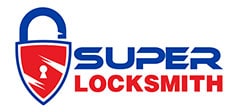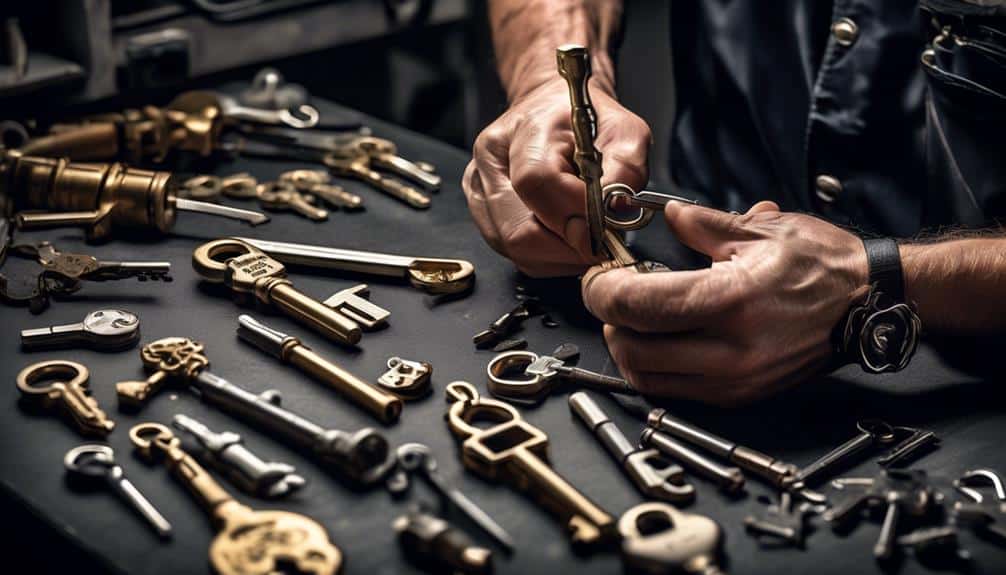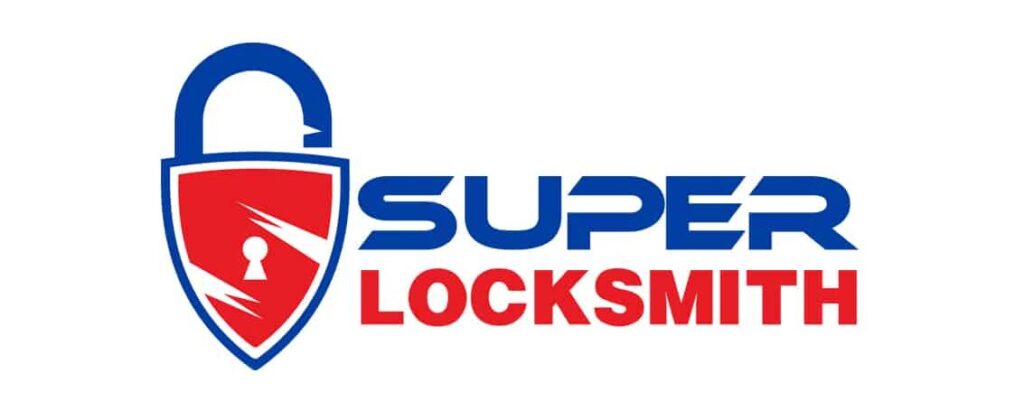So, here we are, ready to embark on a journey into the fascinating world of duplicating skeleton keys.
You see, keys have come a long way since the days of knights and castles. Nowadays, we rely on these little metal wonders to grant us access to our homes, offices, and even our cars. But what happens when we need an extra key or find ourselves locked out? That's where the art of key duplication comes into play.
In this discussion, we will explore the ins and outs of unlocking the process, uncovering the methods and tools used to duplicate skeleton keys, and even delve into the world of vintage and modern keys.
So, buckle up and get ready to uncover the secrets behind duplicating these elusive keys.
Understanding Skeleton Keys
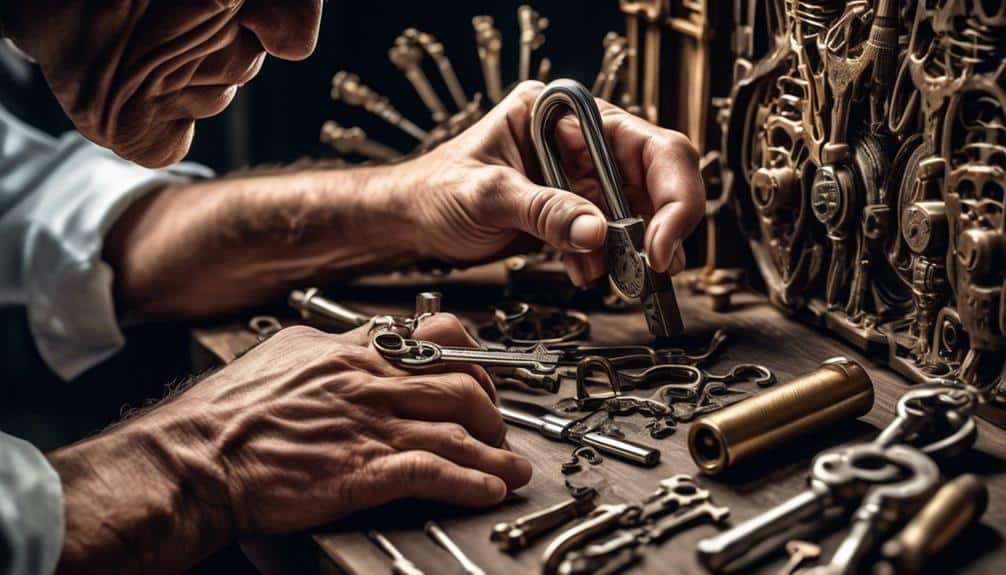
Understanding skeleton keys is essential for anyone interested in the field of lock picking. Skeleton keys have a rich history that dates back centuries. These keys were originally designed to open multiple locks that shared a similar mechanism. Skeleton keys were widely used in the past, especially during the 18th and 19th centuries, when lock designs were simpler and less sophisticated.
The primary purpose of a skeleton key is to bypass traditional lock mechanisms. It achieves this by having a unique shape that allows it to manipulate the lock components effectively. The key is designed with a long, slender shaft and a variety of irregularly shaped teeth or wards. These teeth align with the individual lock pins, allowing the key to bypass them when turned. This design enables the key to open multiple locks, making it a versatile tool for locksmiths and lock pickers.
Skeleton keys have been used for various purposes throughout history. In addition to their use by locksmiths, they were also commonly used by law enforcement agencies and property owners who needed access to multiple areas. Skeleton keys were particularly prevalent in large estates and mansions, where one key could unlock numerous doors.
Understanding the history and uses of skeleton keys provides valuable insight into the field of lock picking and the development of lock mechanisms. By delving into the intricacies of these keys, lock pickers can gain a deeper understanding of how locks function and how to manipulate them effectively.
Types of Skeleton Keys
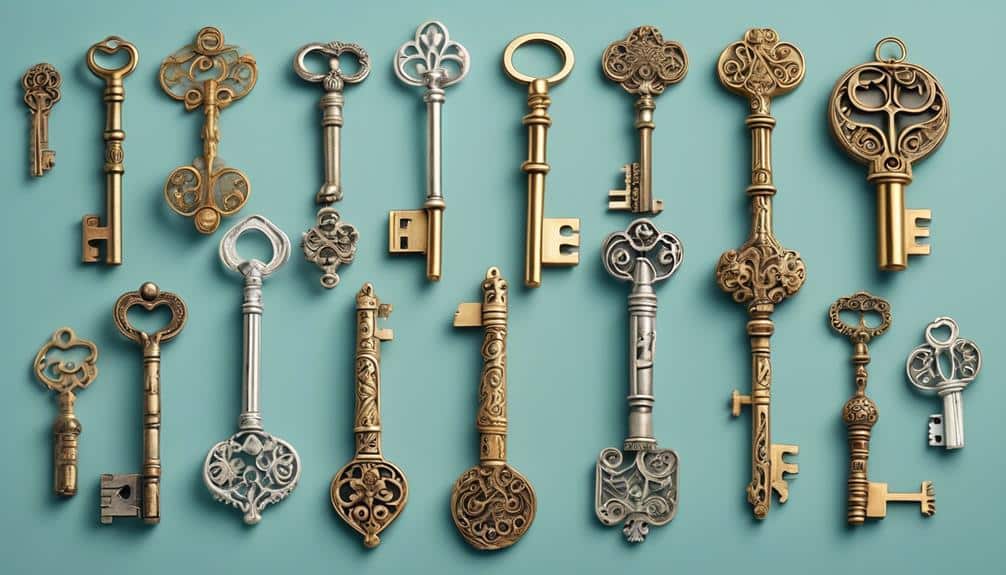
There are several distinct types of skeleton keys that have been used throughout history. These vintage skeleton key designs vary in shape, size, and functionality, but all serve the same purpose of unlocking various locks. To better understand the different types of skeleton keys, let's take a closer look at their characteristics in the table below:
| Type of Skeleton Key | Description | Notable Features |
|---|---|---|
| Barrel Key | Has a cylindrical shaft with a series of ridges or grooves | Used for lever locks and padlocks |
| Bit Key | Features a flat, rectangular blade with a series of notches | Commonly used for warded locks |
| Tubular Key | Has a round, hollow shaft with several pins or tumblers | Used for pin-tumbler locks |
| Double Bit Key | Contains two identical bitting surfaces | Provides increased security and versatility |
These vintage skeleton key designs showcase the ingenuity and craftsmanship of locksmiths from the past. However, with the advent of advanced key duplication techniques, replicating these keys has become more accessible. Today, locksmiths and enthusiasts can utilize modern tools and techniques to accurately reproduce these intricate designs, preserving the history and functionality of skeleton keys.
Importance of Key Duplication
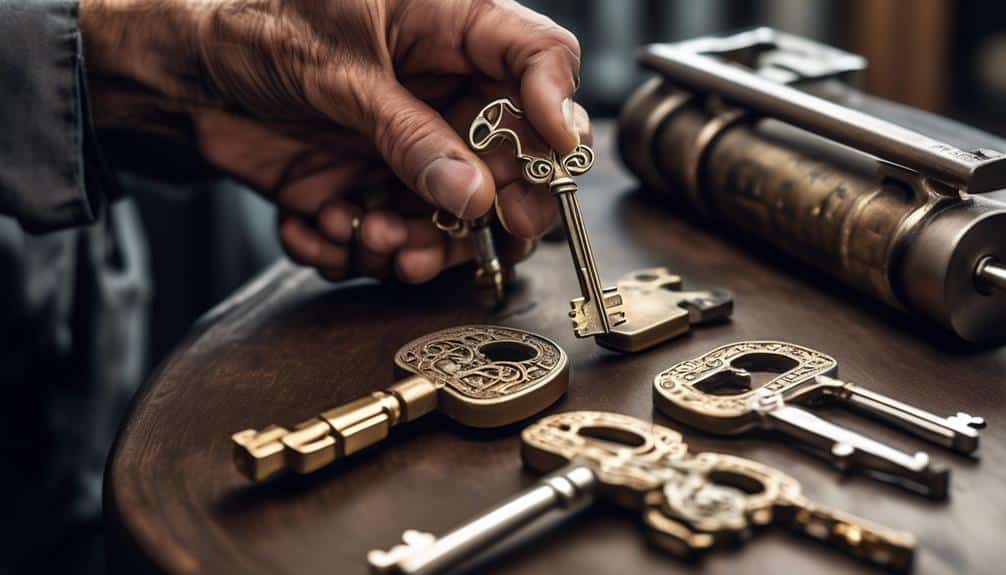
Key duplication plays a crucial role in ensuring the accessibility and security of various lock systems. The importance of key duplication can't be overstated, as it provides several benefits that are essential for maintaining the functionality of lock systems.
One of the main benefits of duplicating keys is the convenience it offers. Having multiple copies of a key allows for easy access to locked spaces, reducing the need for individuals to carry around and keep track of a single key. This is particularly useful in situations where multiple individuals require access to the same locked area, such as in office buildings or apartment complexes.
Another significant advantage of key duplication is the enhanced security it provides. By having multiple copies of a key, individuals can ensure that they've backup options in case of loss or damage to the original key. This eliminates the risk of being locked out and the need for expensive lock replacements.
Additionally, duplicating keys allows for controlled access to specific areas, as only authorized individuals can possess duplicate keys. This helps prevent unauthorized entry and protects sensitive information or valuable assets.
Key Duplication Methods
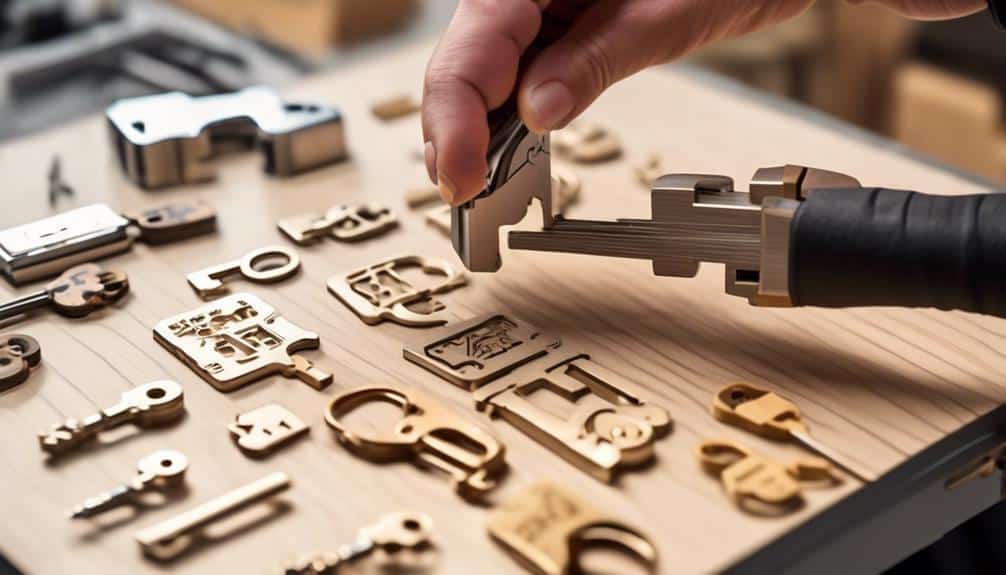
Let's now explore the various methods used for duplicating keys.
Traditional key copying has been a popular method for years. It involves the use of key cutting machines and skilled locksmiths.
Advancements in technology have introduced modern laser technology, which offers a more precise and efficient way of duplicating keys.
Additionally, for those who prefer a do-it-yourself approach, there are now DIY key duplication kits available. These kits allow individuals to make copies of their keys at home.
Traditional Key Copying
To duplicate traditional keys, one can utilize various key duplication methods. These methods are designed to accurately reproduce the shape and configuration of the original key, allowing for seamless replacement or duplication.
Here are two commonly used key duplication methods:
- Manual Key Cutting:
This method involves using a key duplicating machine that requires manual operation. The original key is placed in the machine, and a cutting tool is used to trace the contours of the key onto a blank key. The cutting tool then carves out the duplicate key, replicating its shape and structure.
- Automated Key Cutting:
In this method, an automated key cutting machine is used. The machine is programmed with the specifications of the original key, and it automatically replicates the key by cutting a blank key to match those specifications. This method is faster and more efficient than manual key cutting, as it eliminates the need for human intervention.
Modern Laser Technology
Now, moving our focus to the advancements in key duplication methods, we delve into the realm of modern laser technology.
Laser key cutting and laser engraving techniques have revolutionized the process of duplicating skeleton keys. Laser key cutting uses a concentrated beam of light to precisely cut the key's metal, resulting in a highly accurate reproduction. This method eliminates the need for manual manipulation and ensures a clean, smooth finish.
Laser engraving techniques, on the other hand, allow for intricate designs and patterns to be etched onto the key's surface. This not only enhances the aesthetic appeal but also adds an extra layer of security by incorporating unique identifiers.
These modern laser technologies have greatly improved the efficiency and precision of key duplication, making it an essential tool in locksmithing.
DIY Key Duplication
One of the key duplication methods that can be done by individuals themselves is the use of key duplicating machines. These machines are designed to accurately cut duplicate keys based on the original key's specifications.
Here are two key duplication techniques using key duplicating machines:
- Manual Duplication:
- Place the original key in the machine's clamp.
- Adjust the machine's settings to match the original key's depth and spacing.
- Activate the machine to cut the duplicate key.
- Remove the duplicate key from the machine and check for accuracy.
- Automated Duplication:
- Use a key duplicating machine with an automated feeding system.
- Insert the original key into the feeding mechanism.
- Activate the machine to feed the key through the cutting mechanism.
- Collect the accurately cut duplicate key.
Tools for Duplicating Skeleton Keys
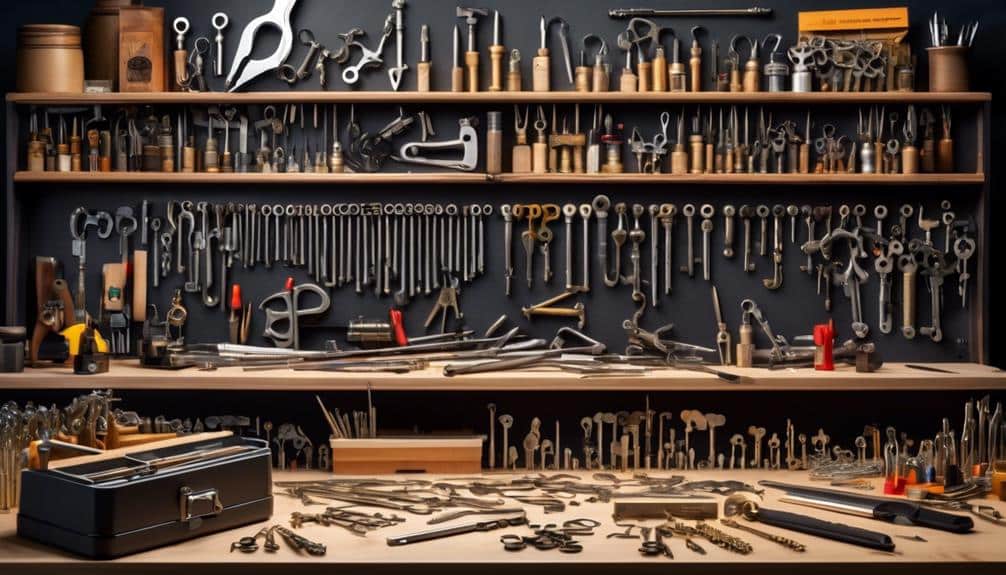
When it comes to duplicating skeleton keys, there are several key duplication methods that can be employed. These methods involve the use of essential cutting tools and precision measurement techniques.
Key Duplication Methods
Multiple tools are available for duplicating skeleton keys efficiently and accurately. When it comes to key duplication methods, there are two main approaches: traditional and digital.
For traditional key duplication, locksmiths use manual tools such as key cutters, key blanks, and files. These tools allow them to carefully replicate the grooves and notches of the original key onto a new blank. This method is commonly used for standard locks and provides a reliable and cost-effective solution.
On the other hand, digital key duplication utilizes advanced technology and specialized equipment. Locksmiths can use computerized key cutting machines that can scan and replicate the precise shape and pattern of the original key. This method is particularly useful for high-security locks and specialty keys that have intricate designs or complex mechanisms.
Essential Cutting Tools
To efficiently duplicate skeleton keys, locksmiths rely on a specific set of essential cutting tools. These tools are designed to ensure accuracy and precision in the key duplication process.
One of the key cutting techniques utilized is the use of a key duplicator machine. This machine is equipped with a cutting wheel that's capable of replicating the precise grooves and notches of the original key onto a blank key. The cutting wheel is controlled by a lever or a motor, allowing the locksmith to control the depth and angle of the cuts.
Additionally, locksmiths use other key duplication equipment such as key blanks, calipers, and files to fine-tune the duplicate key and ensure a perfect fit.
These essential cutting tools are indispensable for locksmiths in their quest to create accurate and functional duplicate skeleton keys.
Precision Measurement Techniques
Precision measurement techniques play a crucial role in the process of duplicating skeleton keys, ensuring the accuracy and exact replication of the original key's grooves and notches onto a blank key. To achieve this precision, skilled locksmiths employ various measurement tools and techniques.
Here are two examples:
- Calipers:
- Digital calipers: These precise measuring instruments allow locksmiths to measure the depth, width, and spacing of the grooves and notches on the original key with utmost accuracy.
- Vernier calipers: These manual tools provide accurate measurements through the use of a sliding scale and a main scale, enabling locksmiths to measure the key's dimensions with precision.
- Key gauge:
- Key profile gauge: This tool helps locksmiths determine the exact shape and size of the original key's grooves and notches, ensuring that the duplicated key is an exact replica.
While precision measurement techniques are essential for key duplication, it's important to note that certain limitations exist, such as the need for specialized tools and expertise to accurately replicate complex key designs.
Step-by-Step Guide to Key Duplication
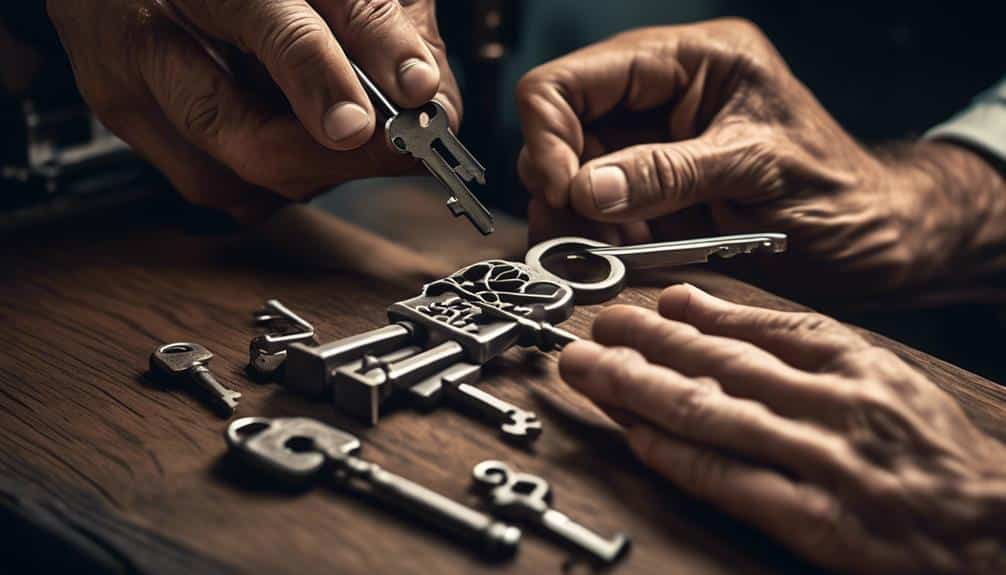
In order to duplicate a key, we'll carefully follow a step-by-step guide to ensure precision and accuracy.
First, we need to have a thorough understanding of key blanks. These are uncut keys that serve as the foundation for duplication. Key blanks come in various shapes and sizes, so it's crucial to select the correct one that matches the original key.
Next, we must prioritize key duplication safety precautions. It's essential to work in a well-ventilated area to minimize exposure to any potential fumes or chemicals. Additionally, wearing protective gloves and safety glasses is recommended to prevent any accidents or injuries during the process.
Once we've the appropriate key blank and safety measures in place, we can begin the key duplication process. We'll start by placing the original key and the key blank in a key duplication machine. This machine will trace the grooves and cuts of the original key and replicate them onto the blank.
After the tracing process, we'll carefully remove the duplicated key from the machine. It's crucial to handle the key with care to avoid any damage or misalignment of the newly cut grooves.
Common Challenges in Key Duplication
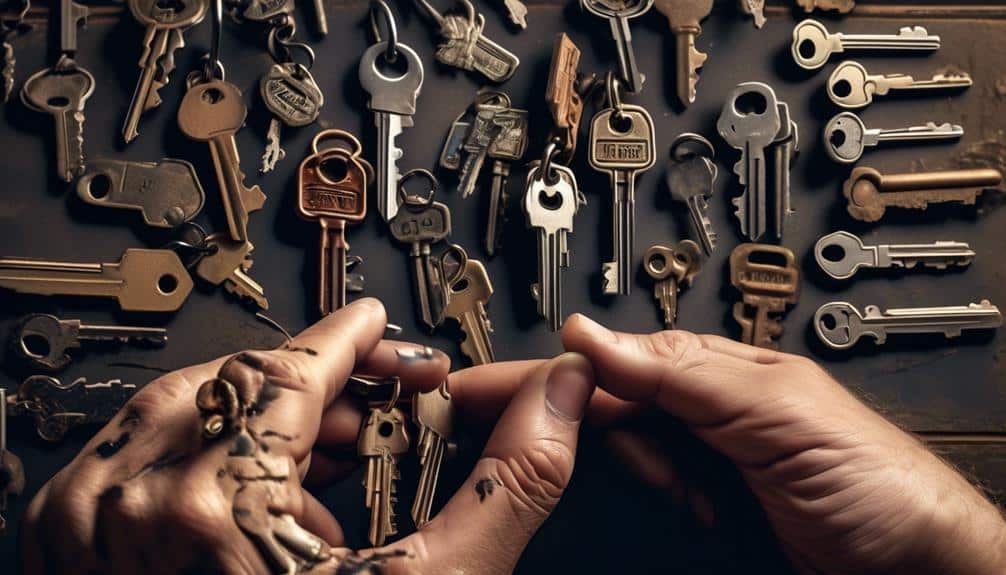
When it comes to key duplication, there are certain limitations that we need to be aware of. Some keys, such as high-security or restricted keys, can't be easily duplicated due to their unique design and additional security features.
However, with the right tools and expertise, these duplication obstacles can be overcome. By understanding the limitations and finding appropriate solutions, we can successfully duplicate a wide range of keys, ensuring convenience and accessibility for our clients.
Key Duplication Limitations
One of the common challenges in key duplication involves ensuring the accurate reproduction of intricate key designs. This challenge becomes particularly pronounced when dealing with key duplication for restricted keys and key duplication for antique skeleton keys. Here are the limitations that arise in these situations:
- Key duplication for restricted keys:
- Restricted keys are designed to prevent unauthorized duplication, making their reproduction more difficult.
- Special authorization or access to proprietary key cutting machines may be required to duplicate restricted keys.
- Key duplication for antique skeleton keys:
- Antique skeleton keys often feature unique and intricate designs that are no longer in production.
- Finding a locksmith or key cutting service with the knowledge and equipment to accurately duplicate these keys can be challenging.
Overcoming these limitations requires expertise, specialized tools, and a deep understanding of key designs to ensure an accurate duplication process.
Overcoming Duplication Obstacles
To overcome the various challenges in key duplication, expertise, specialized tools, and a deep understanding of key designs are essential.
Key cutting errors can occur due to a variety of reasons, such as incorrect measurements, worn-out cutting blades, or incorrect calibration of the key cutting machine.
Troubleshooting key duplication requires a systematic approach. Firstly, we must ensure that the key being duplicated is clean and free from any debris or damage.
Next, we need to carefully examine the original key to identify any unique features or irregularities that may affect the duplication process.
It's crucial to use high-quality cutting blades and calibrate the machine correctly to avoid any inaccuracies.
Tips for Successful Key Duplication
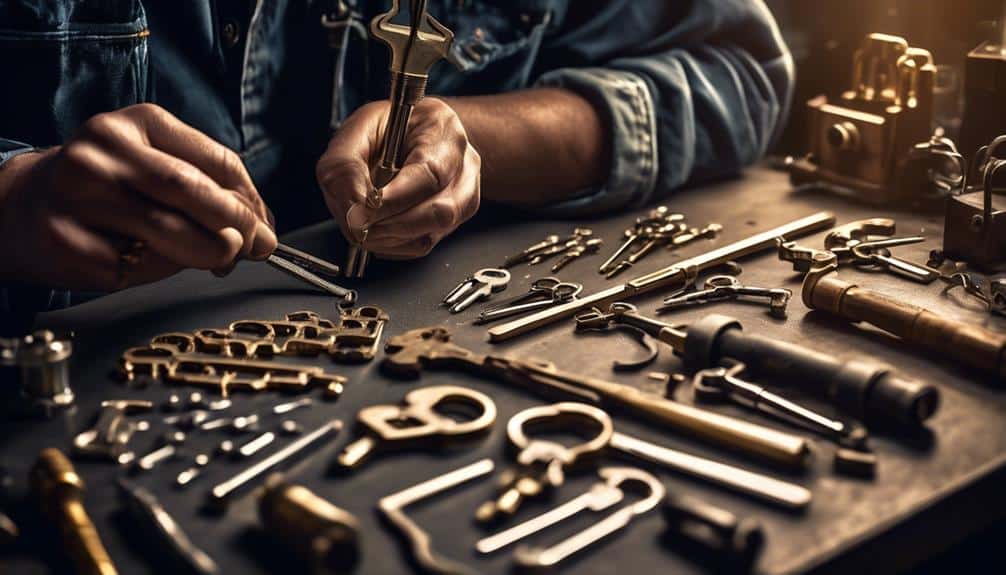
In order to ensure successful key duplication, it's advisable to employ precise techniques and utilize high-quality tools. When it comes to key duplication, there are several common mistakes that can hinder the process. To help you troubleshoot and avoid these errors, here are some tips to keep in mind:
- Choose the right key blank: Selecting the correct key blank is crucial for a successful duplication. Make sure to match the key blank to the original key, considering its shape, size, and profile.
- Maintain proper alignment: Proper alignment is essential during key duplication. Misalignment can lead to inaccurate cuts and an ineffective duplicate. Always ensure that the key and the blank are aligned correctly before making any cuts.
- Use high-quality cutting tools: Investing in high-quality cutting tools is essential for accurate key duplication. Cheap or worn-out tools can result in poorly cut keys that may not function properly.
- Check for key wear: Before duplicating a key, check for any signs of wear or damage on the original key. This can help identify any potential issues that may affect the duplication process.
Key Duplication for Vintage Skeleton Keys
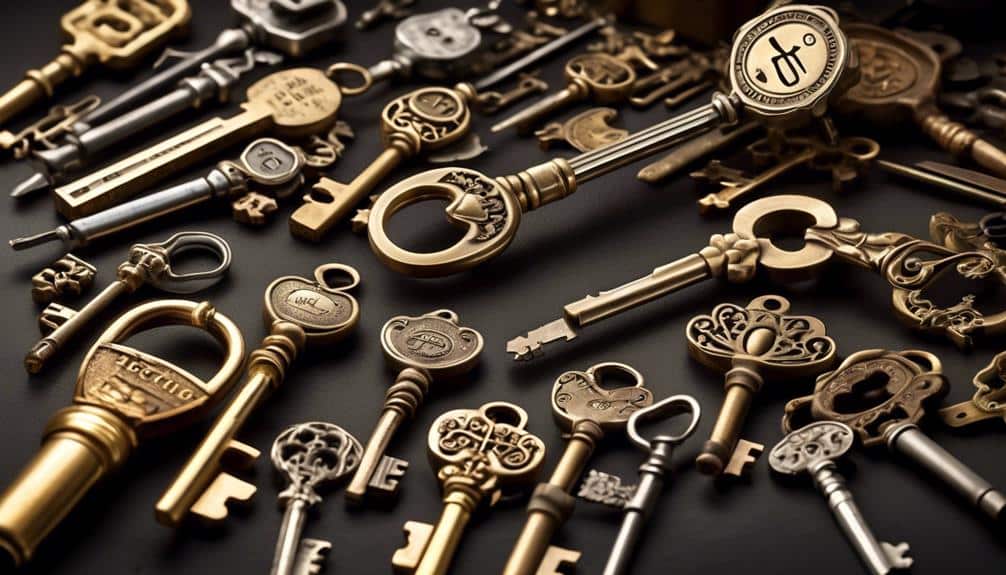
When duplicating vintage skeleton keys, it is crucial to apply the same precise techniques and high-quality tools as mentioned in the previous subtopic to ensure successful key duplication. Vintage key reproduction requires a meticulous approach to capturing the intricate details and unique characteristics of the original key. By using advanced techniques and specialized tools, we can create accurate skeleton key replicas that maintain the charm and authenticity of the vintage originals.
To produce high-quality vintage key replicas, we recommend the following steps:
| Steps | Description |
|---|---|
| 1. Research | Study the design and history of the vintage skeleton key to understand its unique features and purpose. |
| 2. Measurements | Take precise measurements of the key, including its length, width, and depth, as well as the positions of any teeth, notches, or wards. |
| 3. Materials | Select high-quality materials that closely resemble the original key, such as brass or steel. |
| 4. Reproduction | Use specialized tools, such as key cutting machines or 3D printers, to reproduce the vintage key with utmost accuracy. |
Key Duplication for Modern Skeleton Keys
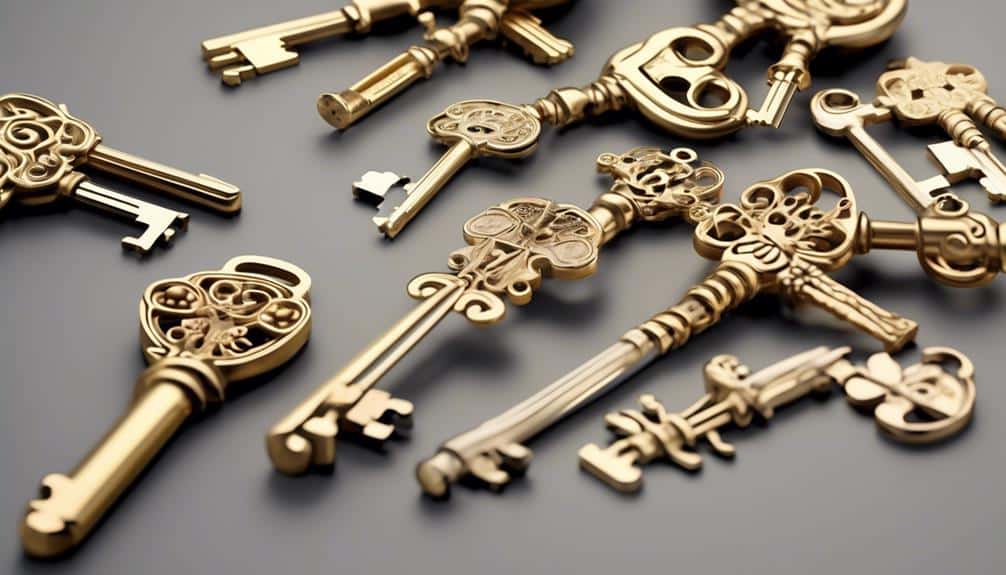
For modern skeleton keys, the process of duplicating keys requires specialized techniques and tools to ensure accurate replication. Key duplication techniques have evolved to keep up with the advancements in key copying methods.
Here are some key aspects to consider when duplicating modern skeleton keys:
- Precise Measurements: Modern skeleton keys often have intricate designs and unique grooves. To accurately duplicate these keys, precise measurements are essential. Specialized calipers and measuring tools are used to capture the exact dimensions of the original key.
- Computer-Aided Design (CAD): Advanced key duplication methods utilize CAD software to create digital replicas of the original key. This allows for precise replication by capturing every detail and groove of the key.
- Laser Cutting: Laser cutting technology is employed to replicate the complex grooves and cuts found in modern skeleton keys. The laser accurately cuts the key blank, ensuring a precise copy of the original key.
- High-Precision Key Copying Machines: Key duplication machines equipped with high-precision cutting mechanisms are used to replicate modern skeleton keys. These machines are capable of producing accurate duplicates by following the digital blueprint obtained from the CAD software.
Key Duplication Services: DIY or Professional?
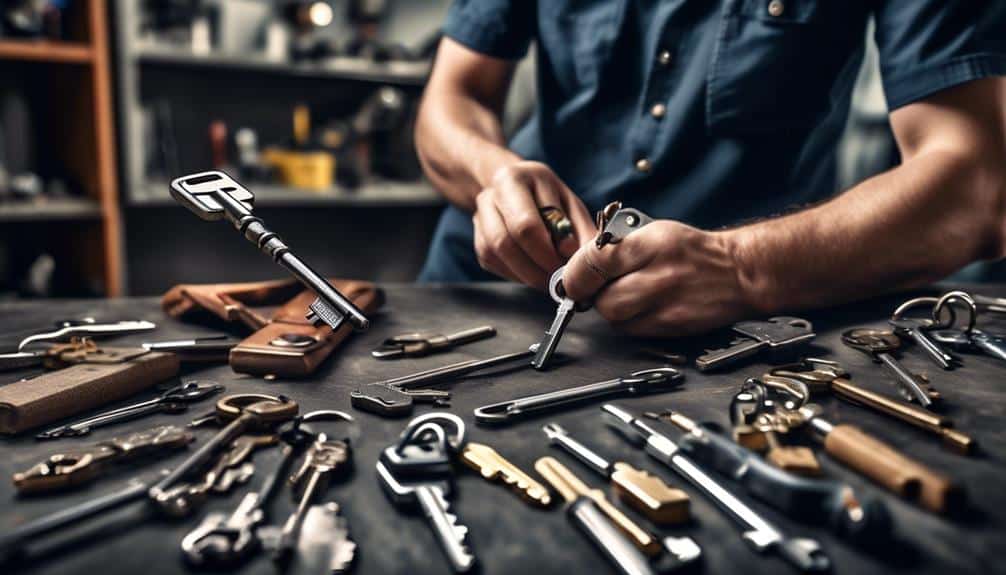
After understanding the intricacies involved in duplicating modern skeleton keys, it's important to consider whether key duplication services should be performed DIY or by a professional. While DIY key duplication may seem like a cost-effective option, it's crucial to weigh the potential risks and benefits before making a decision.
When it comes to DIY key duplication, there are a few tips to keep in mind to achieve satisfactory results. Firstly, ensure that you have access to quality duplication equipment and materials. This includes having a reliable key cutting machine, accurate measurements of the original key, and high-quality blanks. Additionally, be patient and careful during the duplication process, as even minor errors can render the duplicate key useless. Lastly, it's always a good idea to practice on spare keys before attempting to duplicate an important key.
On the other hand, opting for professional key duplication services offers several benefits. Professional locksmiths have extensive experience and expertise in duplicating keys accurately and efficiently. They possess the necessary tools and knowledge to handle various types of keys, including complex skeleton keys. Moreover, professional key duplication services often come with guarantees, ensuring that you receive a functional duplicate key.
Frequently Asked Questions
What Are Some Common Mistakes to Avoid When Duplicating Skeleton Keys?
Common mistakes to avoid when duplicating skeleton keys include:
- Using improper tools, such as worn-out key cutters or incorrect key blank sizes.
- Neglecting to clean the original key properly, which can result in a flawed duplication.
- Failing to double-check the key's alignment and depth before making the duplicate.
- Not following best practices, like using proper lubrication or maintaining a steady hand.
Avoiding these mistakes ensures precise and efficient skeleton key duplication.
Are There Any Legal Restrictions or Regulations Regarding the Duplication of Skeleton Keys?
When it comes to the duplication of skeleton keys, it's important to consider the ethical implications.
Additionally, there are legal restrictions and regulations in place to prevent the unauthorized duplication of keys. Engaging in illegal duplication can have serious consequences, such as legal penalties and potential harm to security systems.
It's crucial to understand and respect these regulations to ensure the safety and integrity of key duplication processes.
Can Skeleton Keys Be Duplicated Using 3D Printing Technology?
Skeleton keys can't be duplicated using 3D printing technology due to its limitations. While 3D printing is capable of creating intricate designs, it can't replicate the precise internal mechanisms required for skeleton keys.
However, there are alternative methods available for duplicating skeleton keys, such as traditional key cutting techniques or utilizing specialized key duplication machines. These methods ensure the accurate replication of the key's unique shape and functionality.
Are There Any Specific Tools or Techniques That Should Be Used When Duplicating Vintage Skeleton Keys?
When duplicating vintage skeleton keys, there are specific tools and techniques that should be used to ensure the best results and maintain the integrity of the keys.
It's important to follow vintage skeleton key restoration techniques, which involve carefully cleaning and repairing any damage on the keys.
Additionally, best practices include using precision tools such as files and key cutters to accurately duplicate the key's shape and dimensions.
These steps will ensure a successful duplication process and preserve the historical value of vintage skeleton keys.
How Can I Ensure the Accuracy and Precision of the Duplicated Skeleton Key?
To ensure accuracy and precision when duplicating skeleton keys, proper measurement and calibration are of utmost importance. We must take into account the intricacies of the original key, using specialized tools and techniques for duplication.
By meticulously measuring and calibrating each cut, we can ensure that the duplicated key perfectly matches the original. This precision is crucial in maintaining the functionality and effectiveness of the key.
With our expertise and attention to detail, we guarantee the highest level of accuracy in duplicating skeleton keys.
